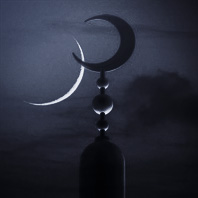The new moon knowledge
On this page we have compiled some information about the new moon. Some details are comparable with the full moon knowledge. In this respect, a visit to the page “full moon knowledge” will be worthwhile, too.
We have tried to keep these explanations simple and in layman’s terms and not be too scientific. Astronomy experts may have to turn a blind eye to some areas 😉
If you should have any questions, you may contact us via e-mail at any time.

Definition of the new moon
The new moon is when the Earth and the Sun are facing each other and the Moon is in between them. This is when the Moon is not visible to the day side of the globe, because it is flooded by sunlight. For all people on the night side of the globe it is not visible either, because it is behind the horizon (on the other side of the Earth).

Solar eclipse at the new moon
When the Moon is perfectly aligned with the Sun and the Earth, it casts a shadow onto the Earth, which we experience as solar eclipse (actually the darkening of the sun). Although the Moon might be 400 times smaller than the sun, but also 400 times closer to Earth, both celestial bodies appear to be of the same size in the sky. Hence, this is how the Moon can cover the Sun. When this happens, we are talking about a total solar eclipse. Solar eclipses can only take place at a new moon, just like lunar eclipses can only take place at a full moon.
Information about the solar eclipse
How long does the new moon last?
The new moon is – just like the full moon – an astronomical event in space and does not rely on whether it is day or night time for us people here on Earth. This is why the time of the new moon is usually indicated in Universal Time = UT and needs to be converted into the local time of the individual countries, if one wants to know the exact time of the new moon.
The actual time of the new moon is very short and because you cannot watch it (other than during a solar eclipse), it is sometimes mistakenly assumed that the new moon’s duration lasts from the time of the last waning moon crescent, to the moment of the first visible waxing moon crescent. In reality, the new moon is merely a short and mathematically defined point in time.
How often is the new moon?
The lunar cycle lasts on the average approx. 29.5 days, but varies in length spread throughout the year. Because this duration is shorter than the calendar month, there are months with two new moons (called “black moon – in analogy to the “blue moon” of the full moon), and some Februaries without a new moon.
Information about the blue moon
Everything new?
The word “new moon” contains the “new” in many languages:
• “Neumond” (German)
• “new moon” (English)
• “nouvelle lune” (French)
• “luna nueva”(Spanish)
• “lua nova” (Portuguese)
• “luna nuova” (Italian)
It is evident that people have always looked at the new moon as a new beginning. The Moon “renews” itself and also something in the lives of people. Of course, this is more connected to faith and the power of thoughts than with the positioning of celestial bodies.
In Islam, the new moon has a special meaning, because it creates the basis of the moon calendar and hence provides a time frame for religious practice. Also in other religions like Buddhism, there are festivals that are celebrated on a new moon.
